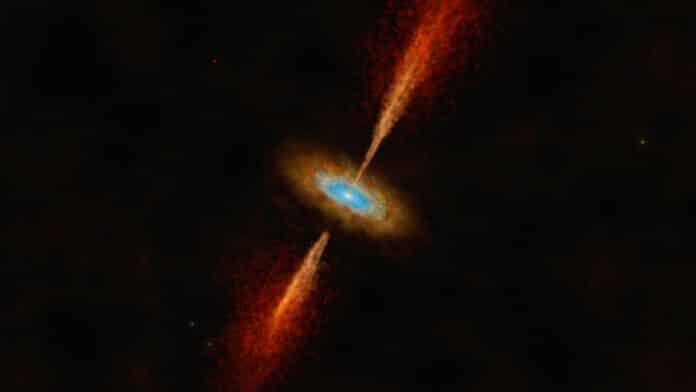In a remarkable discovery, astronomers have found a disc around a young star in the Large Magellanic Cloud, a galaxy neighbouring ours. It’s the first time such a disc, identical to those forming planets in our own Milky Way, has ever been found outside our galaxy. The new observations reveal a massive young star, growing and accreting matter from its surroundings and forming a rotating disc. The detection was made using the Atacama Large Millimeter/submillimeter Array (ALMA) in Chile, in which the European Southern Observatory (ESO) is a partner.
“When I first saw evidence for a rotating structure in the ALMA data I could not believe that we had detected the first extragalactic accretion disc, it was a special moment,” says Anna McLeod, an associate professor at Durham University in the UK and lead author of the study published today in Nature. “We know discs are vital to forming stars and planets in our galaxy, and here, for the first time, we’re seeing direct evidence for this in another galaxy.”
This study follows up observations with the Multi Unit Spectroscopic Explorer (MUSE) instrument on ESO’s Very Large Telescope (VLT), which spotted a jet from a forming star — the system was named HH 1177 — deep inside a gas cloud in the Large Magellanic Cloud. “We discovered a jet being launched from this young massive star, and its presence is a signpost for ongoing disc accretion,” McLeod says. But to confirm that such a disc was indeed present, the team needed to measure the movement of the dense gas around the star.
As matter is pulled towards a growing star, it cannot fall directly onto it; instead, it flattens into a spinning disc around the star. Closer to the centre, the disc rotates faster, and this difference in speed is the smoking gun that shows astronomers an accretion disc is present.
“The frequency of light changes depending on how fast the gas emitting the light is moving towards or away from us,” explains Jonathan Henshaw, a research fellow at Liverpool John Moores University in the UK, and co-author of the study. “This is precisely the same phenomenon that occurs when the pitch of an ambulance siren changes as it passes you and the frequency of the sound goes from higher to lower.”
The detailed frequency measurements from ALMA allowed the authors to distinguish the characteristic spin of a disc, confirming the detection of the first disc around an extragalactic young star.
Massive stars, like the one observed here, form much more quickly and live far shorter lives than low-mass stars like our Sun. In our galaxy, these massive stars are notoriously challenging to observe and are often obscured from view by the dusty material from which they form at the time a disc is shaping around them. However, in the Large Magellanic Cloud, a galaxy 160 000 light-years away, the material from which new stars are being born is fundamentally different from that in the Milky Way. Thanks to the lower dust content, HH 1177 is no longer cloaked in its natal cocoon, offering astronomers an unobstructed, if far away, view of star and planet formation.
“We are in an era of rapid technological advancement when it comes to astronomical facilities,” McLeod says. “Being able to study how stars form at such incredible distances and in a different galaxy is very exciting.”
Journal Reference
- A. F. McLeod, P. D. Klaassen, M. Reiter, J. Henshaw, R. Kuiper, and A. Ginsburg. A likely Keplerian disk feeding an optically revealed massive young star” to appear in Nature. DOI: 10.1038/s41586-023-06790-2 | Research Paper
